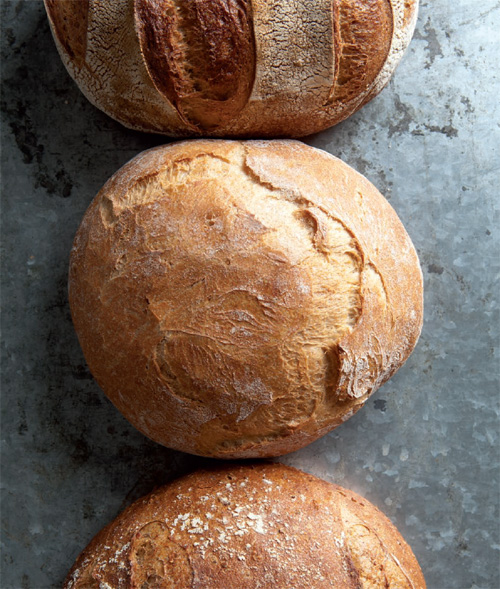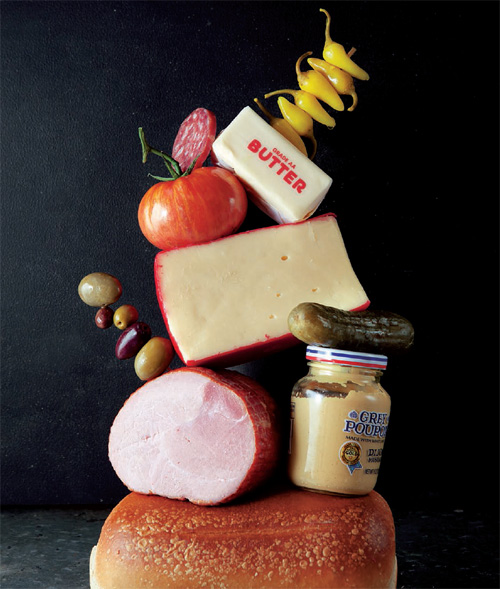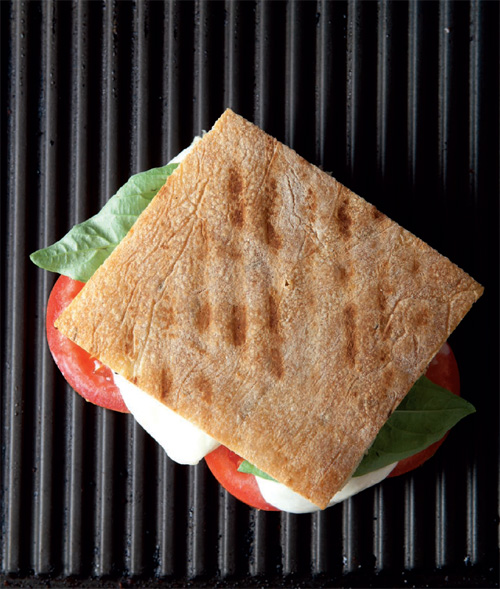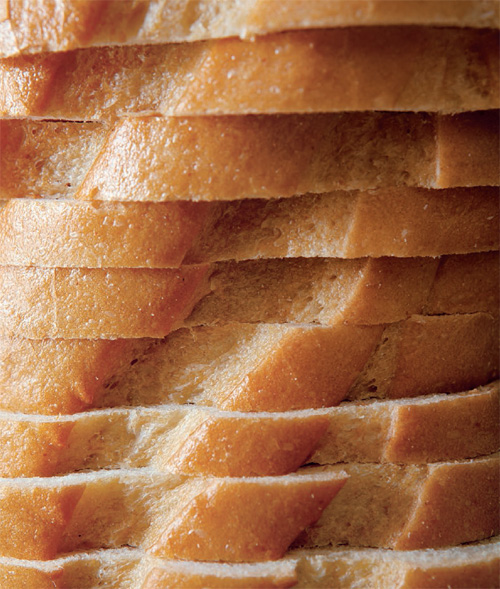ONE PANINO, TWO PANINI…
Bread and cheese have always been a seductive combination, but the Italians do it best with panini. These “little bread rolls” have become a category of sandwich par excellence, ubiquitous in cafés everywhere. The appeal comes from layering simple, quality ingredients—thinly sliced salami or prosciutto, melting cheeses such as mozzarella or fontina, flavor-packed pestos and spreads—on a hefty slab of focaccia or country bread. Smash it down with conviction on the press, and you’ve got a hot, delicious creation.
In these pages, you’ll find a panino for every craving and occasion. Recipes start with well-loved classics, using the Italian-inspired ingredients most of us associate with panini: savory cured meats, briny olives, grilled eggplant and zucchini, and saucy meatballs. Signature hot sandwiches join in the mix, such as meaty Reubens, spicy ham-and-pickle Cubanos, and cheesy croques. Other recipes riff on lunchtime favorites, featuring grilled chicken, deli ham or turkey, heaps of roasted veggies, even brown-bag PB&J. These sandwiches could be served cold, but with a few tweaks and a quick stint in the press, they transform into warm and toasty panini.
In the second half of the book, see just how versatile and modern panini can be, drawing on special ingredients like grilled salmon or juicy lamb burgers. Slip in fresh flavors with leafy herbs—adding woodsy thyme to mushrooms, or fragrant sage to apples and cheddar. Look for international flavors, such as Spanish manchego cheese or fiery North African harissa. And discover unexpected combinations, such as sweet summer nectarines with Brie, prosciutto with fig jam, roasted pork with pickled onions, and much more.
Panini are effortlessly simple to assemble and cook, as easy to pile on a platter for a picnic or whip up as lunch for one. Whatever you are in the mood for, you'll find countless variations and temptations to savor throughout this book.
THE BEST INGREDIENTS
Perfect panini are easy for anyone to make. Success really depends on using the best-quality ingredients that you can find.
Bread Bread is the foundation of every panino, from the crunchy, toasted exterior to the soft interior. Shop for herbed focaccia, rustic country loaves, fresh baguettes, challah or brioche, and petite rolls. Think about flavor, from tangy sourdough to rye, seeds to whole grains, even walnuts or olives.
Cheese Cheese holds it all together. Choose good semi-firm melting cheeses, which respond well to heat. Aged mozzarella and provolone are the Italian staples; cheddar and Gruyère are solid contenders. But don’t overlook spreadable fresh cheeses, luscious triple creams, and boldly flavored blues.
Meats and Seafood Pick up high-quality deli meats like sliced turkey, ham, corned beef, or pastrami, and seek out charcuterie such as mortadella, salami, capicola, or prosciutto. Roasted pork or grilled steak and chicken breasts can all be thinly sliced for stacking. Fry up bacon or sausages, or for a lighter meal, use fresh seafood such as salmon, tuna, prawns, or crabmeat.
Veggies Layer in freshness and crunch with vegetables, from juicy tomatoes and tender greens to slices of roasted eggplant, zucchini, and bell pepper. Tuck a few Italian tricks away in the pantry: jarred roasted peppers, marinated artichoke hearts, spicy peperoncini, and sun-dried tomatoes.
Fruits Swap out vegetables for fruit, especially those that pair well with cheese. Crisp autumn apples and pears love a sharp cheddar or Stilton. Summer stone fruits such as nectarines, peaches, and plums make sweet companions to soft Brie or roasted pork, and pineapple rings caramelize gorgeously on the grill.
Spreads Spreads add another boost of flavor. Try creamy rémoulade, garlicky aioli, briny tapenade, or basil or cilantro pesto. For a sweet note, try fig jam or quince paste, or even a dollop of chutney.
PANINI PERFECTION
You’ve lined up some quality ingredients, and it’s time to stack and press. With these tips and tricks, anyone can craft panini like a maestro.
How to stack Strive for the perfect ratio of bread to filling—not too scant, but not too much of a mouthful. Cheese should go first, then layer meats or veggies in more or less equal parts. Consider flavor and moisture as you go. This is where herbs and spreads come into play, and a judicious slice of tomato here or a swipe of salsa verde there can go a long way.
Go for gooey A good melting cheese (see THE BEST INGREDIENTS section) and plenty of it is the key to holding a panino together in all of its gooey glory. Cheese should go directly next to the bread, helping to create cohesion with the surrounding ingredients. Two layers, one next to each bread slice, works best. Depending on the spread, you can also layer cheese on one side and spread on the other.
Commit to crispy Once fully stacked, you can press panini just as they are, but the savvy cook will quickly brush some oil or butter on the outside of the bread. A fruity olive oil or creamy butter adds flavor, and helps to toast the bread to a golden finish.
Fire it up Preheat the press, skillet, or grill so that the bread sizzles on impact. Electric presses will automatically heat to a set temperature, and some have a light to indicate when they’re ready. If using a frying pan or grill, it’s up to you to maintain the right level. Aim for medium to medium-high heat, and be ready to adjust the heat during cooking.
Smash it down Don’t be afraid to press! It’s what separates panini from their cold counterparts. For the prettiest grill marks, set the sandwiches down at an angle to the ridges, and try to resist nudging or peeking. Halfway through cooking, rotate the sandwiches 90 degrees to create a crosshatched pattern.
TOOLS
Panini are low maintenance. Essentially, all you’ll need is something to heat the sandwiches and a method to press them down.
Panini press or electric grill A dedicated panini press is arguably the best tool for the job. These countertop electric devices are specifically designed to grill panini evenly and at just the right temperature. Most feature an adjustable top plate to accommodate all sandwiches, from elegantly thin to jaw-achingly thick. Both panini presses and electric grills often feature ridges to create grill marks, and come in nonstick materials for easy release. An electric grill is slightly more all-purpose, but similar in appearance and use. Intended for searing meats, it can easily accommodate panini as well. Check that you are using the correct temperature settings for sandwiches, and turn halfway through cooking so that the panino is evenly pressed.
Frying pan or grill pan Even without a sandwich press, you probably already have all of the tools you need to create delicious panini at home. Choose a heavy skillet, preferably cast-iron, preheat well, and check the heat regularly for the best results. You just need to improvise a way to press down on the sandwiches. Consider purchasing a panini weight, complete with a handle, that rests on top while the sandwich cooks, or, use a second heavy pan or a brick wrapped in clean aluminum foil to weigh down the sandwich.
Outdoor grills For maximum flavor, fire up the grill. Cooking panini outdoors over gas or charcoal requires a little more attention, but delivers fabulously smoky flavor. Take care not to stoke the heat too high, and experiment with raking the coals to one side. Buttery, cheesy sandwiches should be watched carefully in case of flare-ups, so stand by with tongs if you need to scoot panini over to a cooler safety zone. If you’re using a heavy pan, just make sure it’s entirely heatproof, including the handle.
Other tools A good serrated knife helps to rip into crusty bread and a pastry brush makes it easy to cover the surface with olive oil or melted butter. A heatproof spatula or tongs are also key for flipping.



